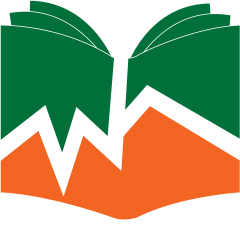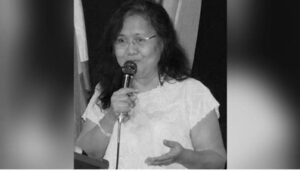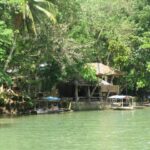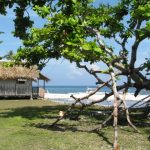The Mentors Series remembers the women who’ve shaped how I see Art, Writing, Faith, Editing, and Translation. These are biographical fragments from conversations, visits, and stories that found their way into my own journey. I am hardly able to capture the full scope of their extraordinary lives, but at Page-a-Writer.com, I hope to inspire confidence and courage in telling these stories.
No. 1: Mila Aguilar (1949–2023) — Poet, Activist
I first met Mila Aguilar in 1992, at a Bible study I was sometimes invited to lead at the Liongoren Gallery. It wasn’t the kind of fellowship I was used to, artists and writers filled the room with questions, debates, and playful arguments that sometimes went in circles. Creatives being themselves, they didn’t come by the clock, so the study often started late and ended even later, with me quietly hoping and praying that the Holy Spirit would step in and calm us down.
In that circle of pilosopos, another mentor friend, Norma Liongoren, had gathered all sorts of inquirers from assorted “faiths” and half-faiths. Mila Aguilar was one of the unique voices with her sharp, articulate questions and insights that felt uncannily prophetic. She fit in as a kind of devil’s advocate, yet beneath all the probing burned a deep passion for her newfound faith.
Only later did I learn how many lives Mila had lived before that evening: a political detainee under Martial Law, granted amnesty after EDSA; a revolutionary who once believed in the CPP-NPA; and always, a poet whose words carried her through both freedom and confinement.
Early Poems and the “Blue Period”
At the time, she was based in her mother’s basement in her ancestral home in UP Village, working with her student Ernie to cut and splice videotapes for Channel 13 and prepare programs on cultural issues. On the side, she was assembling her poetry collection Journey: An Autobiography in Verse, which traced her “Blue,” “Red,” “Purple,” and later faith-filled years.
Curioser and curiouser, I visited her there, often staying late as noon slipped into night while I watched her work and listened to her stories. It wasn’t safe to go home, so I stayed. Looking back, it may have seemed like I was stalking her with curiosity, but really I couldn’t get enough of the life she was unfolding for me, piece by piece.
Mila once told me she had been a “libertine” in college. I remember looking the word up, half-embarrassed, half-intrigued. It made sense when I later read her “Blue Period” poems from the late ’60s, sensual, rebellious verses alive with the thrill of freedom from home (even though UP was just a stone’s throw from her parents’ house, they had put her in a dorm) and the joy of feeling beautiful and young.
“She blushed full bloom… / Alluring raindrop worlds…”
Revolution and the “Red Period”
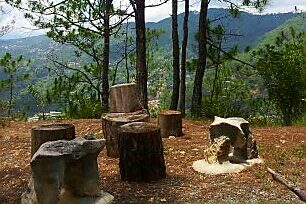
Mila came from a sheltered upbringing, never needing to do chores at home, and yet when she married a cadre, she had to learn to live rough in the mountains: cooking, hiding, moving from one safehouse to another. That contrast, between privilege and hardship, is etched sharply in her “Red Period” poems, where she wove together love and lust, romance and rebellion:
“Gentle father… Help flatten the ruling class…”
Later, as head organizer for the CPP NPA in Mindanao, Mila continued writing, now producing manifestos she typed and mimeographed herself. She championed a centralized movement and successfully expanded masa-centric recruitment. In her poems, manifestos, and journals, art and life were inseparable, and she distrusted anyone not fully committed to the ideology. In the heat of the revolution, she was a fierce propagator and advocate.
Imprisonment, Motherhood, and the “Purple Period”
After a marriage within the NPA system, Mila left her young son in her mother’s care for safety, since theirs wasn’t a usual arrangement. The choice weighed on her, a quiet ache she carried each day. By 1983, she had resigned from the movement, disillusioned with the revolution, and was teaching at St. Joseph Academy in Quezon City under a different name. Around that time, she was arrested, after more than a decade of running incognito in the hills. In prison, her longing and regret grew sharper. More than freedom from walls or guards, Mila yearned to be with her son and to reclaim lost time. Her prison poems reflect these tensions, her sorrows, reckonings, and a yearning for a freedom she could not yet name, one beyond being guarded, interrogated, or bound to any ideology.
In Pigeons for My Son, she wrote:
“Why cage pigeons who prefer free flight / in the vaster, bluer skies?”
Mentor and Legacy
I met Mila in my thirties, long after her revolutionary years. She told her stories in fragments—over coffee, in passing, or when making a point. Her cinematic life felt intense but abstract, yet I could tell she had lived it, later sharing it as part of her Christian testimony.
What stood out most to me was how her newfound faith brought clarity. The limits of her own striving, her belief in youth and intellectual prowess, and the idea that Marxist ideology could save her country became, to her, naive and pointless notions. Her nine lives, as she wrote in the The Nine Deaths of M, were her true miracles, the narrow escapes from death, and friends and family who sheltered her at great risk. Every painful relationship, loveless marriage, and fourteen-year separation from her son became more than what life had given her; it was what God allowed, part of a plan greater than her activist agenda.
In ’94, Mila drove me from my rented bedspace in Guadalupe to another in Tindalo, my suitcases piled at the back. On the road, she shared her love stories, intriguing, unguarded, and listened to my own confession about an unrequited love with her quiet, “Motherly-Theresa” patience. By then we were friends, and this once so-called “libertine” often showed me that living courageously didn’t mean plunging into uncertainty without the Word of God. She spoke freely about love, sex, marriage, and divorce, but when it came to motherhood, she drew a firm line. She would tell me I was naïve, and though I was embarrassed, I knew she was right. She had seen even more extraordinariness in the lives of people in the countryside, those she met on her many walks and runs in the literal hills of struggle.
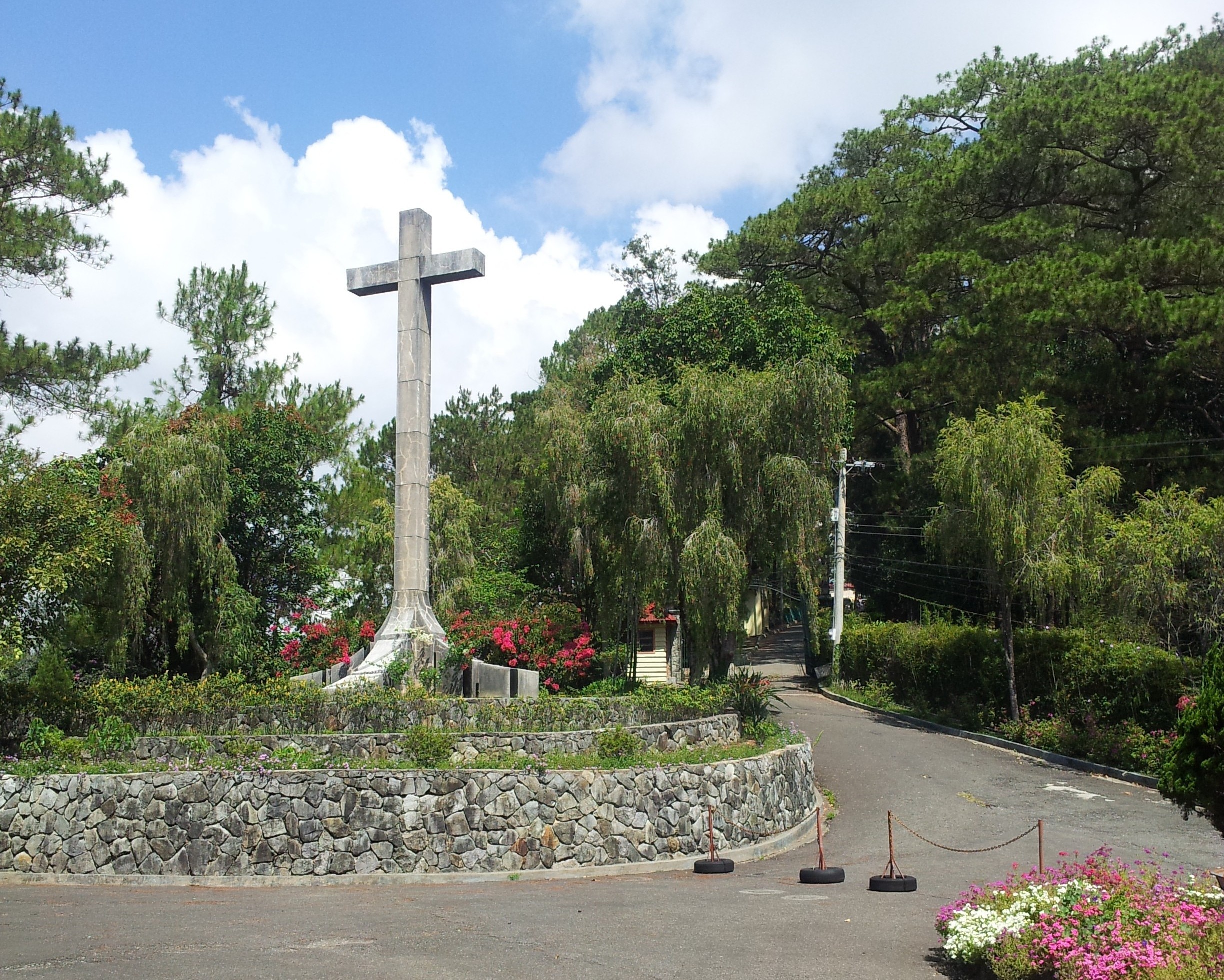
A Return to Faith
By the time I came to know her, Mila’s poems had already traced the arc of her life: Blue, Red, Purple, and finally what I think of as her “White Period” of faith. In our Bible study, she spoke with conviction that only Christ could bring about a true revolution, one that begins not with ideology or armed struggle, but with a change of heart in each individual. Being a new creation in Christ was never just for personal benefit, but always for the good work God intended for every believer. She had long stopped believing that the CPP-NPA had the answers for our people’s woes, yet if anything, her faith had only deepened her love for the country.
Mila’s born-again faith was never just Christian jargon. To her, it was a new way to fight oppression, rooted in God’s love. She once put her faith in awakening the masses to a revolution to save the country, but she came to see its failure. Being with her deepened my own sense that our lives are not ours to steer. Left to ourselves, we get lost. We need God in small struggles and in the fight for our country’s redemption. That redemption, a new revolution against the principalities (Ephesians 6:12), is already under way, but we must follow the true Leader of this fight for real freedom.

